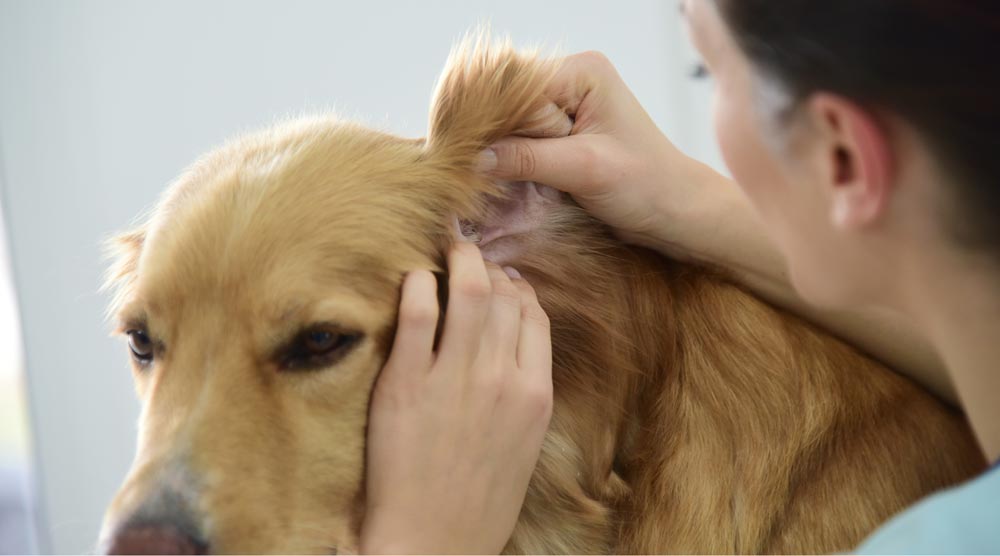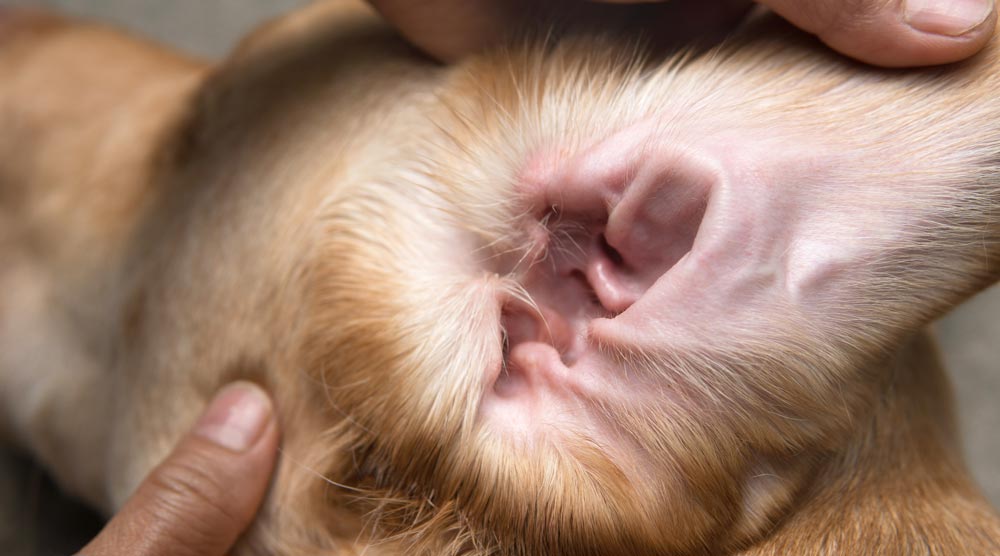What does it mean when a dog’s ears feel hotter than normal? Here are seven common reasons for hot ears and why this symptom should never be ignored.
Contents
In this article, we’ll go through seven reasons your dog’s ears might be hot. We’ll also discuss what might cause both hot ears and head shaking.
Note: Regardless of the reason, we always recommend contacting a vet immediately if your dog’s ears are noticeably hotter than normal.
Are Dogs Ears Supposed To Be Hot?
Dogs have a higher normal body temperature than humans. To the touch, your dog’s ears should feel a bit warmer than your hands.
However, if your dog’s ears feel hot, this isn’t something that should be ignored. Hot ears could either indicate a general fever or a health problem specific to the ears.
Sometimes hot ears are accompanied by other symptoms, such as excessive scratching or head shaking. In other cases, your dog may seem fine other than having hot ears. You shouldn’t try to diagnose the problem yourself – contact a vet for a professional diagnosis.
How Hot Should a Dog’s Ears Be?
The most accurate way to determine if your dog’s ear temperature is normal is to use a thermometer. A normal reading should be between 100.5° to 103°F (38° to 39.4°C). You should contact your vet if the temperature reads higher than 103°F (39.4°C).
You’re unlikely to take your dog’s temperature unless you notice other symptoms though, which is why many people first notice hot ears when stroking their pet. This is less accurate, but it’s often obvious when the dog’s ears are hotter than normal

Should You Take Your Dog’s Temperature By Ear?
While you can take your dog’s temperature by ear, this typically isn’t an accurate method and isn’t advised. There are many things that can affect the ear temperature, which is why vets would usually only take the a dog’s temperature rectally.
If your dog is scared or resistant to the thermometer, do not force it. Seek your vet’s help if you cannot get a reading at home.
When Should You Contact a Vet?

If your dog’s ears feel hot to touch, or you’ve confirmed their temperature is above 103°F (39.4°C) with a thermometer, you should contact your vet.
It’s possible that your dog has a fever, meaning that their body temperature is too high. A fever is a sign of a health concern and isn’t something you should ignore or wait to get better on its own.
Even if it’s just the ear that’s hot, rather than a systemic fever, an elevated ear temperature shows there is a medical issue that needs to be treated.
Other signs that might indicate a problem with your dog’s ears include:
- Discharge in or around the ear
- Excessive scratching or pawing at the ear
- Excessive head shaking
- Redness or discoloration of the ear
- Different or unpleasant odor
- Unusual sensitivity
Your dog might experience these symptoms due to a variety of causes. Failing to treat the problem could lead to serious consequences, such as an ear drum rupture or worsening fever, so you should always contact your vet.
7 Reasons Why A Dog’s Ears Might Feel Hot
There are many possible reasons why your dog’s ears might feel hot. While it might indicate a fever, this isn’t always the case. Here are seven reasons your dog’s ear might feel hot and what to do about it.
1. Ear Mites
Ear mites are tiny parasites that can live on the surface of your dog’s ear. After fleas, they are the second most common external parasite found on dogs. Ear mites can cause extreme irritation to your dog’s skin and can result in hotness, excessive itching, redness, and discharge.
These symptoms can also look like an ear infection, so it’s critical to have your vet examine your dog and make sure they get the right treatment.
Because ear mites are so small and difficult to detect, it’s best to keep an eye out for symptoms of ear mites rather than trying to spot the mites themselves. Untreated ear mites can also cause a secondary ear infection.
Contact your vet for treatment immediately if you think your dog is showing symptoms of ear mites.
Vet Note From Dr Linda Simon: “If we take a close look in the surgery, we may well see very small white ‘dots’ moving about the ear in dogs with ear mites. I rarely see ear mites in adults, but they are a common issue in young pups.”
2. Fever (Systemic Infection)
Like humans, dogs can run fevers when they have an infection that the body is fighting.
While the whole body will have an elevated temperature during a fever, it’s often most noticeable when touching the ears. This is mainly due to the lighter covering of fur, but also because we often touch our dog’s ears, making a temperature change easier to notice.
A fever is a symptom of another condition, with some of the most common including:
- Urinary tract infections (UTIs)
- Bacterial diseases such as Lyme disease or a staph infection
- Viral diseases such as parvo, distemper, or rabies
- Organ infection
- Infected wounds or bites
- Ingestion of poisons or toxins
- Infected or abscessed teeth
A fever is a serious symptom that needs immediate veterinary care. Don’t delay contacting your vet if your pet has a fever, as this will allow the underlying condition to get worse.
3. Bacterial Ear Infection
Due to the L-shape of a dog’s ear canal, ear infections are much more common in dogs than in people. Hotness, redness, inflammation, and discharge are all signs of a bacterial ear infection.
Since symptoms of an ear infection are similar to ear mites, have your dog’s ears examined and treated by a vet. Different bacteria require specific treatments, and infections can frequently contain multiple types of bacteria.
Keeping your dog’s ears clean and dry is the best way to prevent ear infections. Chronic ear infections can also indicate an underlying issue, such as allergies or hypothyroidism.
4. Yeast Ear Infection
The shape of a dog’s ear canal also makes it a common location for yeast infections. Dogs with floppy ears, hair growing in their inner ears, or that frequently get wet are also more at risk for a yeast ear infection.
In addition to hotness, discharge and an odor, yeast infections will frequently be visible on the outer part of your dog’s ear. The ear may be crusty, or the hair may look matted.
Always contact your vet for treatment of a yeast ear infection. The treatment will vary based on both the location in the ear and what’s causing the infection.
Vet Note from Dr Linda Simon: “While we cannot know for sure if a dog has a yeast or bacterial ear infection without examining the discharge under a microscope, there are some telltale signs of a yeast infection. These include a musty smell and a darkening and thickening (lichenification) of the skin within the canal.”
5. Bruising (Hematoma)
Another possible reason for ear hotness is that part of the ear has become badly bruised. This leads to localised inflammation and raised temperature.
Bruising that contains a solid clot of blood and swelling, also called hematomas, is caused by blood vessels rupturing in the ear flap. Unlike a flat bruise, a hematoma will be squishy, with a similar consistency to a water balloon. Excessive head shaking due to an infection, mites, or other irritation can result in an ear hematoma.
If you notice your dog’s ear is hot, swollen, or bruised, you should consult with your vet. Since hematomas are likely the result of another ear-related condition, the root cause needs to be diagnosed and treated.
Hematomas in the ear are typically treated by draining the blood with a large needle, along with steroids to prevent them from re-filling. If the hematoma happens repeatedly, they dog may need a procedure to tack the ear flaps together.
6. Heatstroke
Heatstroke is a dangerous condition that occurs when the dog’s body is unable to cool down fast enough in hot conditions.
Dogs suffering from heatstroke will have a body temperature higher than 103°F (39.4°C). However, unlike a fever, this temperature is caused by the external heat or exercise rather than an infection.
Common symptoms of heatstroke include:
- Rapid breathing
- Gums that are tacky or dry to the touch
- Lethargy
- Disorientation
- Abnormal coloring in their gums
- Seizures
Heatstroke is an emergency that must be treated immediately. While you’re on the way to the vet, try to actively cool them by turning on the air conditioning and offering a drink of water.
You can reduce the risk of heatstroke by making sure your dog is in a well-ventilated area, has access to water, and can take refuge in a cool, shaded area whenever needed.
Why are dogs so susceptible to heatstroke though? Unlike humans, dogs do not have sweat glands, so they lower their body temperature through panting. This makes regulating their body temperature much more difficult, since they only have one place they can exchange hot air for cooler air.
Combine this with being covered in insulating fur, and you can see why dogs are much more at risk of heatstroke.
In addition, your dog might not always stop playing or exercising, even when exhausted and overheated. It’s important to monitor your dog closely in hot temperatures, keep them as cool as possible, and make sure they don’t over-exert themselves.
7. Allergies
It’s estimated that 10-20% of dogs suffer from allergies. Allergies can cause a variety of symptoms, including making the dog’s ears red and hot. An allergy can also lead to a secondary ear infection, due to the ear becoming inflamed and reducing airflow.
Talk to your vet if you think your dog is suffering from allergies. Various treatment options are available once your vet has determined which allergen is triggering the symptoms.
Dog’s Ears Hot And Head Shaking – What Does It Mean?
Head shaking is another sign that your dog has pain or irritation in the ear. Any of the conditions above can cause it, although ear mites, bacterial infections, and yeast infections are the most likely to lead to excessive head shaking.
In particular, ear mites are extremely irritating to your dog’s skin. He may try to shake his head or scratch the area to get relief.
Bacterial and yeast infections are also common causes of head shaking. In addition to causing itching, the discharge from infections can be uncomfortable, and your dog will try and remove it by shaking.
It’s important to see your vet if your dog’s ears are hot and they are shaking their head. Not only do you need to address the root cause, but excessive head shaking can also lead to ruptured blood vessels in your dog’s ear.
Dog’s Ears Hot And No Fever – What Does It Mean?
Not all causes of a hot ear are related to a systemic fever. Ear mites, allergies, and bruising can cause localized irritation to the ear without causing a general fever throughout the body.
Even if your dog doesn’t have a fever, you should still talk to your vet. Anything that can cause your dog’s ears to feel hot must be diagnosed and treated.
Summary
Hot ears can be caused by a variety of health issues, such as ear mites, fever, infection, and heatstroke. These conditions require urgent medical attention, so you should always contact a vet immediately to get an accurate diagnosis.
Do you have any questions about why a dog’s ears might be hot? Please use the comments below.




